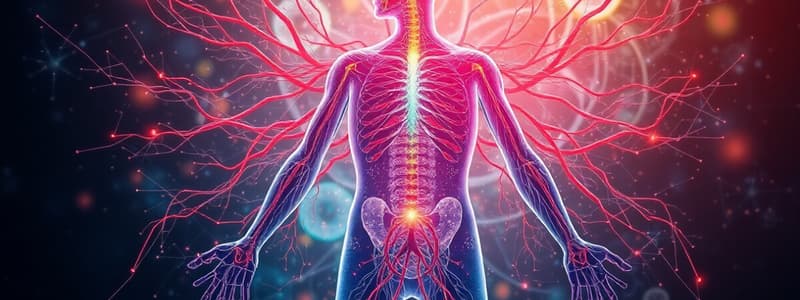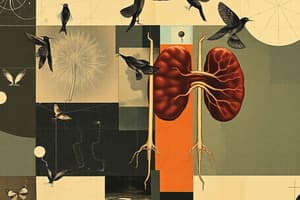Podcast
Questions and Answers
What is the primary function of homeostasis in a biological system?
What is the primary function of homeostasis in a biological system?
- To amplify external stimuli for quicker responses.
- To maintain a stable internal environment despite external changes. (correct)
- To allow the internal environment to fluctuate randomly.
- To facilitate rapid changes in the internal environment.
Which sequence accurately describes the homeostatic regulation pathway?
Which sequence accurately describes the homeostatic regulation pathway?
- Variable → Receptor → Control Center → Effector (correct)
- Control Center → Receptor → Effector → Variable
- Receptor → Variable → Effector → Control Center
- Variable → Effector → Control Center → Receptor
What characteristic distinguishes the endocrine system from the nervous system?
What characteristic distinguishes the endocrine system from the nervous system?
- The nervous system elicits rapid, brief responses, while the endocrine system's responses are slower and prolonged. (correct)
- Both systems regulate muscular contraction exclusively.
- The endocrine system uses neurotransmitters for communication.
- The endocrine system transmits nerve impulses.
Sensory receptors, afferent neurons, a central processor, efferent neurons, and effectors are components of which system?
Sensory receptors, afferent neurons, a central processor, efferent neurons, and effectors are components of which system?
Which of the following is an example of a neuroendocrine structure?
Which of the following is an example of a neuroendocrine structure?
How does negative feedback regulate hormone production?
How does negative feedback regulate hormone production?
Which cellular process is directly influenced by hormones?
Which cellular process is directly influenced by hormones?
Why does the solubility of a hormone affect its mechanism of action?
Why does the solubility of a hormone affect its mechanism of action?
How do agonists exert their effects on hormone receptors?
How do agonists exert their effects on hormone receptors?
What is the role of LH (luteinizing hormone) in follicular development?
What is the role of LH (luteinizing hormone) in follicular development?
What crucial genetic factor determines whether a developing gonad becomes testes?
What crucial genetic factor determines whether a developing gonad becomes testes?
What is the immediate physiological response that defines acute stress?
What is the immediate physiological response that defines acute stress?
Which system is activated during chronic stress?
Which system is activated during chronic stress?
Which of the following is a common behavioural response to stress in animals?
Which of the following is a common behavioural response to stress in animals?
What is a limitation of using hormonal measurements to assess stress in animals?
What is a limitation of using hormonal measurements to assess stress in animals?
Why is fecal cortisol measurement less accurate than blood cortisol measurement?
Why is fecal cortisol measurement less accurate than blood cortisol measurement?
Which of the following methods of measuring cortisol is best suited for assessing chronic stress?
Which of the following methods of measuring cortisol is best suited for assessing chronic stress?
What did the Shiverdecker Study demonstrate regarding the effect of human interaction on stress levels in shelter dogs?
What did the Shiverdecker Study demonstrate regarding the effect of human interaction on stress levels in shelter dogs?
What is the primary difference between behavioral and hormonal assessments of stress?
What is the primary difference between behavioral and hormonal assessments of stress?
Which of the following best explains the concept of 'sex determination' in the context of reproductive biology?
Which of the following best explains the concept of 'sex determination' in the context of reproductive biology?
Flashcards
What is homeostasis?
What is homeostasis?
Maintaining a stable internal environment in the body.
Homeostatic Regulation pathway
Homeostatic Regulation pathway
Stimulus -> Receptor -> Control Center -> Effector -> Response.
Endocrine system
Endocrine system
Uses chemical messengers to communicate with target organs.
Nervous system
Nervous system
Signup and view all the flashcards
Neuroendocrine system
Neuroendocrine system
Signup and view all the flashcards
Peripheral Endocrine System
Peripheral Endocrine System
Signup and view all the flashcards
Hypothalamus-Pituitary Unit
Hypothalamus-Pituitary Unit
Signup and view all the flashcards
Negative feedback (hormones)
Negative feedback (hormones)
Signup and view all the flashcards
Positive feedback (hormones)
Positive feedback (hormones)
Signup and view all the flashcards
Cell's hormone response
Cell's hormone response
Signup and view all the flashcards
Agonist
Agonist
Signup and view all the flashcards
Antagonist
Antagonist
Signup and view all the flashcards
Sex determination
Sex determination
Signup and view all the flashcards
Stress
Stress
Signup and view all the flashcards
Stress response
Stress response
Signup and view all the flashcards
Acute stress
Acute stress
Signup and view all the flashcards
Chronic stress
Chronic stress
Signup and view all the flashcards
SAM (stress response)
SAM (stress response)
Signup and view all the flashcards
HPA (stress response)
HPA (stress response)
Signup and view all the flashcards
Behavioral assessments(stress)
Behavioral assessments(stress)
Signup and view all the flashcards
Study Notes
Homeostasis
- Dynamic equilibrium is maintained within the body's internal environment
- Balance is maintained across all body systems
Homeostatic Regulation
- A stimulus or change is detected, which is sent to a control system
- This generates a response which is then put into play
- Process: Variable → receptor → control center → effector
Achieving Homeostasis
- Achieved through regulatory mechanisms involving body organs
- Involves the endocrine and nervous systems
Comparing Endocrine and Nervous Systems
Similarities
- Both systems use chemical messengers, specifically neurotransmitters
Differences
- Endocrine system secretions target cells to alter metabolic activities in specific cells
- The nervous system transmits nerve impulses to cause muscle contraction or gland secretion
- Endocrine system effects are slow and prolonged
- Nervous system effects are rapid and brief
The Nervous System
- Sensory receptors pass through afferent neurons to a central processor (brain)
- They then pass through efferent neurons to effectors (muscles or glands)
Endocrine System
- An endocrine gland/cell releases a hormone which targets a specific organ
Classical Vertebrate Endocrine System
- The system has two divisions
Neuroendocrine system
- Neurosecretory neurons release hormones with nerve terminals into the blood or ECF
- Adrenal glands, pituitary gland, and the hypothalamus are examples
Peripheral Endocrine System
- Non-neural tissue has no direct link to the nervous system
- Thyroid, parathyroid, pancreas, and kidneys are examples
Hypothalamus-Pituitary Unit
- The hypothalamus acts as a central regulator of endocrine function
- Pituitary gland secretions are closely controlled by the hypothalamus
- All domestic animals possess a hypothalamus and pituitary unit
- Pituitary hormones are not produced at a constant rate
- Hormone production depends on the animal's physiological needs
Feedback Mechanisms
- Hormones are regulated by feedback mechanisms
- Negative feedback occurs when a hormone decreases its own production
- Positive feedback occurs when additional hormone is released in response to an original hormone release
Roles of Hormones
- Hormones cause changes in cell activity
- They stimulate the production of new proteins
- They activate or inactivate enzymes
- They open or close cell membrane channels
- They cause cells to secrete or release substances
Classifying Hormones
- Hormones are classified by: type of signaling, chemical structure, and solubility
Hormone Classes
- Steroids (sex and stress hormones): cortisol and estradiol
- Peptide hormones: insulin
- Amino acid derivatives: thyroid hormones
- Eicosanoids: prostaglandins
Cell Response to Hormones
- Cells respond to specific hormones through receptors on or inside target cells
- This provides specificity for hormone-cell interactions
Hormone Receptors
- The "lock and key" model describes how a conformational change occurs when a receptor binds to a specific hormone
Solubility
- Solubility dictates where the hormone receptor is located
- Water-soluble hormones cannot cross the cell membrane
- The receptor is located outside the cell (outer surface), ex: insulin and epinephrine
- Fat-soluble hormones can cross cell membranes
- The receptor is located inside the cell, ex: thyroid hormones and steroid hormones
Agonists vs Antagonists
- Agonists bind to a receptor to activate a biological response
- Antagonists bind to a receptor and prevent a response from occurring
- Melengestrol acetate (MGA) is a progesterone receptor antagonist
- Dexamethasone is a glucocorticoid receptor agonist
Hormonal Profile and Follicular Development
- Luteinizing hormone (LH) triggers ovulation
- Progesterone thickens the uterine lining
- Prostaglandins stimulate shedding of the uterine lining
- Estrus is the release of an egg to be fertilized
Defining Male or Female
- Defined by chromosomal, gonadal, hormonal, morphological, and behavioral sex
Sex Determination
- The natural event through which an individual becomes male or female
- The process is Genetic → Gonadal → Phenotypic (physical, observable, behavioral)
- Two main types of sex determination are genetic and environmental
- Genetic sex determination occurs at fertilization through gene combination
- Environmental sex determination occurs post-fertilization and depends on chance, resources, social factors, and temperature
Testes or Ovaries
- Gonads develop based on the presence or absence of the SRY gene on the Y chromosome, which is Y-linked
- The phrase "'Y' makes the guy" refers to this
- Female is the default XX setting
- If SRY is present, male organs (testes) develop
Hormone Production
- Cells that make hormones includes granulosa, Leydig, and theca cells
- Egg and sperm cells do not produce hormones
Stress
- Any environmental change that disrupts homeostasis and is perceived as a threat
Stress Response
- Physiological and behavioral responses re-establish homeostasis
Kinds of Stress
Acute Stress (fight or flight)
- Involves an alarm reaction
- Recovery follows quickly
- Adrenaline is released from the adrenal medulla
Chronic Stress (constant/repeated)
- Adjustments fail to compensate
- Impairs immune system response/general health
- Cortisol is released from the adrenal cortex
Stress Response Systems
Sympathetic-Adrenal-Medullary System (SAM)
- Responds to acute stress
Hypothalamic-Pituitary-Adrenal System (HPA)
- Responds to chronic stress
Social Stress Factors
- Social factors include isolation and introduction
- Feeding factors include competition and restriction
- Management factors include transportation and confinement
- Environmental factors include temperature and habitat loss
- Poor health factors include sickness and neglect
Responding to Stress
- Responses can be behavioural or physiological
Examples
- Behavioural: vocalization and restlessness
- Physiological: increased heart rate and blood pressure
Measuring Stress in Animals
Behavioural Assessments
- Measuring species-specific, learned, and animal preferences
- Downfall: dependent on age, sex, health, and density
Hormonal Measurements
- Measuring stress hormone levels in blood
- Downfall: inducing stress can skew levels and results
Ways of Measuring Cortisol
Blood
- Considered the 'Gold standard'
- Cortisol is secreted directly into the bloodstream
- Downfall: drawing blood is stressful, skewing cortisol levels
Saliva
- There is a linear relationship between free cortisol in blood and saliva
- It is a less stressful sampling procedure
- Only the free cortisol portion is measured
Fecal Matter
- No direct interaction with the animal
- Less accurate due to processes that occur, causing more variability in measurements
Urine
- Measures free cortisol levels
- It can be difficult to collect a sample
- Sampling time needs to be consistent
Hair
- Acts as a biomarker of chronic stress
- It can be cut or retrieved from the environment, meaning no stress to the animal
- It can be transported without compromising samples
Shiverdecker Study
- Proved that human interaction decreased stress levels in shelter dogs
- Blood samples were taken before and after interactions to measure plasma cortisol levels
- Each dog was used as its own control
- Human interactions decreased cortisol levels
Studying That Suits You
Use AI to generate personalized quizzes and flashcards to suit your learning preferences.




